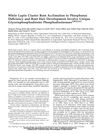Integrative Comparison of the Role of the Phosphate Response1 Subfamily in Phosphate Signaling and Homeostasis in Rice
June 2015
in “
PLANT PHYSIOLOGY
”
TLDR OsPHR3 can help breed rice that efficiently uses phosphate without growth issues.
The study investigated the role of three PHR1 orthologs in rice (OsPHR1, OsPHR2, and OsPHR3) in phosphate (Pi) signaling and homeostasis. It found functional redundancy among these transcription factors, with each playing a role in activating Pi starvation-induced genes. Mutations in any of these factors impaired root hair growth, while overexpression led to Pi accumulation in shoots. Notably, OsPHR3-overexpressing plants showed significant tolerance to low-Pi stress without growth retardation, unlike OsPHR2-overexpressing lines. This suggested that OsPHR3 could be beneficial for breeding rice with improved Pi uptake and use efficiency under Pi-deficient conditions. The study concluded that these transcription factors form a network with diverse roles in Pi regulation in rice.
